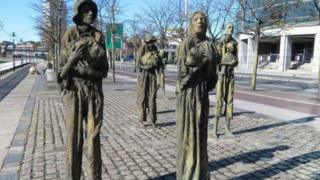Irish famine victims buried in Canada
The remains of 21 people lost in a shipwreck while fleeing the Irish Famine will be buried in Canada on Thursday – 172 years after they died.
The bones of mostly women and children were found on a beach at Cap-des-Rosiers, Quebec, between 2011 and 2016.
Experts have confirmed the remains were from the Carricks ship, which left County Sligo with 180 emigrants at the height of the famine in 1847.
Descendants of those lost at sea said the burial will help bring “closure”.
Pat Ward’s great great uncle Patrick Kaveney boarded the Carricks with his wife Sarah, five daughters and son.
Mr Ward, 63, from Keash, County Sligo, told BBC News NI that the girls, aged between two and 10, died when the ship sank in a storm just miles from Canada.
The Kaveney couple and their son were among 48 survivors. According to historical accounts, the 87 bodies recovered were buried on the beach.
The bones of three children washed up in a storm in 2011, and five years later archaeologists uncovered the remains of 18 others, mostly women and children.
‘They were told to get out’
Parks Canada said the location of the remains and analysis, which showed they had followed a rural diet based on potatoes and suffered diseases associated with malnutrition, confirmed the theory that they were from the Carricks.
The famine killed more than a million Irish people and forced about a million more to emigrate after blight devastated the potato crop.
Mr Ward said it was “very emotional” to think his ancestors may be among those recovered.
He believes they were offered “assisted emigration” by their landlord.
“Families were marrying and dividing the land among themselves, the landlords wanted them out so they could have a fresh start,” he said.
“They were told to get out and their passage would be paid.”
Mr Ward said the story of what happened had partially survived.
“I heard of someone going away and drowning, it was talked about. We all knew about the famine but never knew until recently what happened after they left,” he said
‘They were in sight of a different life’
“They were in sight of land and a different life when the storm broke, you can imagine their hopes. For their bones to wash up after so long is unreal.”
Mr Ward said the religious celebration and burial, which will be held at the Irish Memorial in Forillon National Park, was important to help “bring closure”.
He said it would have “an impact” despite the passage of time.
Mary Krugman, from Mont Clair, New Jersey, said her great great great grandmother Bridget Heally, survived the Carricks shipwreck in which she lost her parents, husband Patrick Crummey and at least two children. She remarried and had her great great grandmother Eleanor Adams.
Ms Krugman, from Mont Clair, New Jersey, said the tale of shipwreck was “a kind of myth” in her family.
She said she had only recently discovered the real story of “misery, loss, resilience and rebirth in a new country”.
“The re-interment of the remains is very meaningful to this family, descended as we are from a survivor,” she said.
Sligo historian Joe McGowan said the story was a fascinating tale of people thrown off their land because they could not pay the rent.
He said it struck a chord with many “as a microcosm of what happened across Ireland”.
Source: Read Full Article



